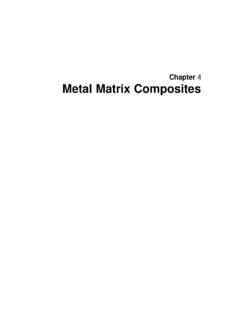Transcription of NANOPARTICLES
1 Technology White Papersnr. 3 NanoparticlesPaul Holister Jan-Willem Weener Cristina Rom n Vas Tim Harper NANOPARTICLES October 2003 NANOPARTICLES Technology White Papers nr. 3 Release Date: October 2003 Published by Cient fica Cient fica, Ltd. Cient fica is the world's largest nanotechnology information company. With a global network of partners, the company organizes both scientific and business conferences and provides information and research to thousands of clients worldwide. Cient fica is the publisher of the Nanotechnology Opportunity Report and TNT Weekly. Cient fica 2003 Page 2 of 11 Reproduction in whole or in part without permission of Cient fica is prohibited.
2 NANOPARTICLES October 2003 Authors Paul Holister Jan-Willem Weener Cristina Rom n Tim Harper Acknowledgments Dr. Jim Golden (Business Development Manager 454 Corporation, USA), Dr. James Baker (CSO NanoBio Corporation and Director of the Center for Biologic Nanotechnology, University of Michigan, USA). Cient fica 2003 Page 3 of 11 Reproduction in whole or in part without permission of Cient fica is prohibited. NANOPARTICLES October 2003 Table of Contents Origin of Scope of this Introduction to Production Vapor Chemical Solid-state Developments in production Coating and chemical modification of Cient fica 2003 Page 4 of 11 Reproduction in whole or in part without permission of Cient fica is prohibited.
3 NANOPARTICLES October 2003 Origin of content The free reports in this series are extracted from the technology reports that make up the Nanotechnology Opportunity Report collection and are designed to offer an introduction to the variety of technologies that fall under the nanotechnology umbrella. The full reports also include 'opportunities' sections, covering the various applications of the technology and their effects on markets, and a list describing the companies involved in the technology. Scope of this report The term 'nanoparticle' is a very general one and is often used to cover materials that are better described using other terms.
4 Occasionally it has been used to describe dendrimers, which are globular polymers and examples of state-of-the-art molecular engineering. This report does not include dendrimers, which are given their own report, under the term NANOPARTICLES . Calling quantum dots NANOPARTICLES (or nanocrystals, as is often done) is less incorrect but detracts from the fact that it is their quantum mechanical properties that are of interest rather than their nanoscale size, although the former are indeed a function of the latter. Quantum dots also deserve separate treatment and have their own report.
5 NANOPARTICLES are often crystalline and end up being referred to as nanocrystals. Such materials are included in this report but nanocrystalline bulk materials, those that contain nanoscale crystalline elements but not separate nanocrystals, are dealt with in a separate report. Introduction to NANOPARTICLES The transition from microparticles to NANOPARTICLES can lead to a number of changes in physical properties. Two of the major factors in this are the increase in the ratio of surface area to volume, and the size of the particle moving into the realm where quantum effects predominate. Figure 1.
6 Water droplets on a wood surface treated with BASFs "Lotus Spray". The coating combines NANOPARTICLES with hydrophobic polymers. Courtesy of BASF, Germany. The increase in the surface-area-to-volume ratio, which is a gradual progression as the particle gets smaller, leads to an increasing dominance of the behavior of atoms on the surface of a particle over that of those in the interior of the particle. This affects both the properties of the particle in isolation and its interaction with other materials. High surface area is a critical factor in the performance of catalysis and structures such as electrodes, allowing improvement in performance of such technologies as fuel cells and batteries.
7 The Cient fica 2003 Page 5 of 11 Reproduction in whole or in part without permission of Cient fica is prohibited. NANOPARTICLES October 2003 large surface area of NANOPARTICLES also results in a lot of interactions between the intermixed materials in nanocomposites, leading to special properties such as increased strength and/or increased chemical/heat resistance. The transition from classical mechanics to quantum mechanics is less gradual. Once particles become small enough they start to exhibit quantum mechanical behavior. The properties of quantum dots (covered in a separate report) is a case in point.
8 These are sometimes called artificial atoms because free electrons in them start to behave in a way similar to electrons bound by atoms in that they can only occupy certain permitted energy states. Additionally, the fact that NANOPARTICLES have dimensions below the critical wavelength of light renders them transparent, a property which makes them very useful for applications in packaging, cosmetics and coatings. Some of the properties of NANOPARTICLES might not be predicted simply by understanding the increasing influence of surface atoms or quantum effects. For example, it was recently shown that perfectly-formed silicon 'nanospheres', with diameters of between 40 and 100 nanometers, were not just harder than silicon but among the hardest materials known, falling between sapphire and diamond.
9 NANOPARTICLES have been used for a very long time, probably the earliest use being in glazes for early dynasty Chinese porcelain. A Roman cup, called the Lycurgus cup, used nanosized gold clusters to create different colors depending on whether it was illuminated from the front or the back. The cause of this effect was not, of course, known to those who exploited it. Carbon black is the most famous example of a nanoparticulate material that has been produced in quantity for decades. Roughly million tons of the material is produced every year. Nanotechnology, though, is about deliberately and knowingly exploiting the nanoscale nature of materials, which would, for many, exclude early use of carbon black from being given the nanotechnology label.
10 However, new production and analysis capabilities at the nanoscale and advances in theoretical understanding of the behavior of nanomaterials certainly mean nanotechnology can be applied to the carbon black industry. NANOPARTICLES are currently made out of a very wide variety of materials, the most common of the new generation of NANOPARTICLES being ceramics, which are best split into metal oxide ceramics, such as titanium, zinc, aluminum and iron oxides, to name a prominent few, and silicate NANOPARTICLES (silicates, or silicon oxides, are also ceramic ), generally in the form of nanoscale flakes of clay.







